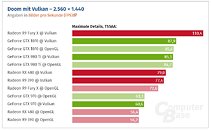Wednesday, July 13th 2016

DOOM with Vulkan Renderer Significantly Faster on AMD GPUs
Over the weekend, Bethesda shipped the much awaited update to "DOOM" which can now take advantage of the Vulkan API. A performance investigation by ComputerBase.de comparing the game's Vulkan renderer to its default OpenGL renderer reveals that Vulkan benefits AMD GPUs far more than it does to NVIDIA ones. At 2560 x 1440, an AMD Radeon R9 Fury X with Vulkan is 25 percent faster than a GeForce GTX 1070 with Vulkan. The R9 Fury X is 15 percent slower than the GTX 1070 with OpenGL renderer on both GPUs. Vulkan increases the R9 Fury X frame-rates over OpenGL by a staggering 52 percent! Similar performance trends were noted with 1080p. Find the review in the link below.
Source:
ComputerBase.de

200 Comments on DOOM with Vulkan Renderer Significantly Faster on AMD GPUs
It makes you wonder if this is a preview of things to come with DX12. I guess time will tell. Until then, I'm going to enjoy this.
wondering if older older hardware (GCN 1st,2nd) show this improvement; if yes, means these gen. are still good to use a while
The fact is you don't gear an architecture to be low level. You gear your game for an architecture.
This fall the old Fury X will come close to a 1080 in most games, and a $200 budget card from AMD will nearly match Nvidia's 1070.
Nvidia has had plenty of time to prepare their cards for the future, but just like how they gave Fermi cards half as much VRAM as they needed; they then stripped Kepler/Maxwell/Pascal of any useful compute hardware. This was done so that 1) It can operate more efficiently in today's inefficient games, 2) People will be forced to upgrade to Volta.
Remember that most developers still used DirectX 11 on Windows while Mac and Linux releases used OpenGL. Why? DirectX 11 was faster.
Though I didn't have time to try it in full, I only saw the number for like a couple minutes. I will have to give it a more in depth try tonight as I am still finishing that game.
In the limited, and very quick peek I took, in one specific area I was getting about 60FPS with everything maxed out at 1440P, except motion blur turned to low (don't like motion blur). When I switched to Vulkan, I saw 100FPS at the lowest in the same area.
I'd say it improved for me quite a bit.
If only more devs would pick Vulkan (or true DX12)
Also this :D
ofc, it's not that amount through the whole game, but wow.
Wish I had Doom so I can test my crappy gear as well.
I am also looking into improvement using AS for scientific computing. It would be awesome if OpenCL can benefit from these as well.